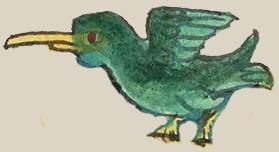huitzilin (Mdz6r)
This element for the hummingbird (huitzilin) has been carved from the compound sign for the place name, Huitzitzilapan. It shows the bird on its feet with its wings raised. It is shown in profile, facing toward the viewer's left. Its beak is yellow, with the upper portion longer than the lower one. Its legs and feet are also yellow. Its body is a two-tone green, which lends it a three-dimensionality.
Stephanie Wood
The Aztecs favored the hummingbird, and they were very aware of the varieties, each having its own name. The color of the feathers and especially their iridescence are remarkable traits, and each color variant gave a different name to the hummingbird, as we see in the Florentine Codex listing of the variations. The deity Huitzilopochtli, Hummingbird-Left, Hummingbird-South, or Hummingbird-Sinister, as various translations interpret the name, was possibly the highest Aztec divinity at the time of contact with Europeans. He may have been an elder named Huitzilin, who became deified. [See: John F. Schwaller, The Fifteenth Month (2019), p. 20.] As found in our online Nahuatl Dictionary, in the entry for huitzilin, Nahua oral tradition mentions the hummingbird as being special for its ability to drink the honey of flowers. The dictionary entry also mentions that hummingbirds were killed and offered in sacrifice in religious rituals. Fray Diego Durán (Historia de las de Nueva España, 1581) adds that hummingbirds were able to be reborn, something he says that he witnessed. Warriors who died on battlefields could also be reborn as hummingbirds. [See: Maysaa Barakat and Mariela A. Rodríguez, Immigrant Family in the Academy (2020).] Names of important leaders included a huitzilin component; examples are Huitzipopoca and Huitzilihuitl.
Furthermore, the hummingbird held an honored place in Nahua thought, as it was connected to the sexual act in the Florentine Codex, connected to Quetzalcoatl in the Codex Borgia, linked to the South and Huitznahuatl (the region of spines or thorns), which has a connection to self-sacrificial acts, and, finally, hummingbirds were associated with warriors who died in combat. [See: Lisardo Pérez Lugones, "Un peculiar ejemplo de arte indígena novohispano," Itinearios 35 (June 2022), p. 219.]
Stephanie Wood
c. 1541, but by 1553 at the latest
Stephanie Wood
hummingbirds, colibrí, colibríes, ave, aves, pájaro, pájaros, pluma, plumas, animals, animales
huitzilin. This specimen is on display in the Museo del Templo Mayor. According to the Museo, it is one of four species of the bird found in offerings of a total of seventeen birds discovered in two different offerings on the Huitzilopochtli side of the Templo. Photograph by Stephanie Wood, 15 February 2023; photo editing and this commentary by Robert Haskett, paraphrasing information provided by the Museo.

huitzil(in), hummingbird, https://nahuatl.wired-humanities.org/content/huitzilin
hummingbird
el colibrí
Codex Mendoza, folio 06 recto, https://digital.bodleian.ox.ac.uk/objects/2fea788e-2aa2-4f08-b6d9-648c00..., image 22, of 188.
The Bodleian Libraries, University of Oxford, hold the original manuscript, the MS. Arch. Selden. A. 1. This image is published here under the UK Creative Commons, “Attribution-NonCommercial-ShareAlike 3.0 License” (CC-BY-NC-SA 3.0).


